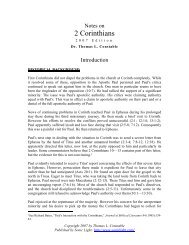1 Samuel - Odessa, Missouri Community of Christ
1 Samuel - Odessa, Missouri Community of Christ
1 Samuel - Odessa, Missouri Community of Christ
You also want an ePaper? Increase the reach of your titles
YUMPU automatically turns print PDFs into web optimized ePapers that Google loves.
20 Dr. Constable's Notes on 1 <strong>Samuel</strong> 2007 EditionGod's mouthpieces. <strong>Samuel</strong> also established a company or school <strong>of</strong> prophets that hetrained to serve God in this capacity. He did not, <strong>of</strong> course, train these men to getrevelations from God. God gave new revelations sovereignly. He probably did, however,train his students in the general functions <strong>of</strong> the prophets that included knowing God'sWord, communicating it effectively, and leading God’s people in worship. Schools <strong>of</strong> theprophets continued through the tenth century B.C. (cf. 2 Kings 2:3). After that time, wehave no record <strong>of</strong> their existence. Individual prophets ministered throughout the history<strong>of</strong> Israel though some generations saw none, others some, and others more prophets. Thegreat writing prophets who have given us the prophetic books <strong>of</strong> the Old Testamentbegan their ministry in the ninth century. There were no prophets who gave newrevelation from God in Israel between Malachi and our Lord's days, about 400 years."It seems plausible . . . to attribute to <strong>Samuel</strong> the development <strong>of</strong> theprophetic movement in a formal sense. Certainly it was always God whoraised up the true prophet, but the structure itself had its inception with<strong>Samuel</strong> and was developed further by Elijah." 50The literary structure <strong>of</strong> chapter 3 focuses on the Lord's sentence <strong>of</strong> destruction on Eli'shouse. This was very significant for the whole nation <strong>of</strong> Israel."A. Absence <strong>of</strong> divine oracles (3:1)B. Eli's fading powers (3:2)C. Three divine calls to <strong>Samuel</strong> (3:3-9)D. A divine oracle to <strong>Samuel</strong> (3:10-15)C'. Eli's request for <strong>Samuel</strong>'s report (3:16-18)B'. <strong>Samuel</strong>'s growing stature (3:19a)A'. Return <strong>of</strong> divine oracles (3:19b—4:1a)" 51Another writer believed that the chiastic structure <strong>of</strong> chapter 3 focuses emphasis onYahweh."A1 <strong>Samuel</strong>'s career in the shadow <strong>of</strong> Eli (v. 1)B1 Eli and <strong>Samuel</strong> in darkness (vv. 2-3)C1 Yahweh breaks through (vv. 4-10)C2 . . . and speaks (vv. 11-14)B2 <strong>Samuel</strong> and Eli in light (vv. 15-18)A2 <strong>Samuel</strong>'s career as a prophet (vv. 19-21)" 52This chapter also shows that God rewards faithful obedience to His word with furtherministry opportunities. <strong>Samuel</strong> became the source <strong>of</strong> God's revelations to Israel. Hecontinued to receive revelations from God and to represent God on earth because heremained faithful. He became the most powerful man in Israel even anointing the nation'sfirst two kings. Like Moses, <strong>Samuel</strong> became an excellent leader <strong>of</strong> the Israelites. Hefunctioned as judge, priest, and prophet. Yet he glorified the kings he appointed, who50 Heater, pp. 129-30.51 Youngblood, p. 592.52 Donald Wiebe, "The Structure <strong>of</strong> 1 Sam. 3: Another View," Biblische Zeitschrift 30:12 (1986):256.








